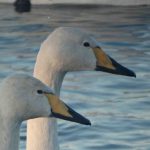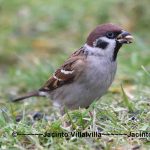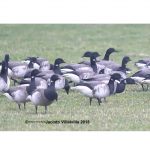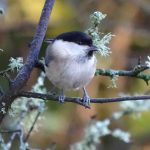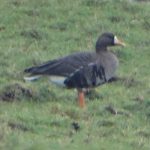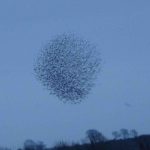Ken and Sarah White organised a trip to the Solway coast, staying at the Mabie House Hotel near Dumfries. Target species for the expedition were Whooper Swans which breed in Iceland, Pink-footed Geese which breed in Eastern Greenland and Iceland, Barnacle Geese which breed on Svalbard, Greenland White-fronted Geese which breed in Greenland and Pale-bellied Brent Geese, which breed on Ellesmere Island in Arctic Canada and migrate over the Greenland ice-cap. The party of 14 gathered on Sunday 7 January at Martin Mere, a reserve of the Wildfowl and Wetlands Trust (WWT) in Lancashire. Regular feeding attracts large numbers of wild birds to a big pool in front of a viewing hide. There were good numbers of Whooper Swans, and many ducks and geese, including Greylag Geese, Shelduck, Wigeon, Teal and Pintail. There were also close views of Ruff and a Black-tailed Godwit. Amongst the many finches and tits on the feeders at the edge of the woodland which borders the reserve were a few Tree Sparrows, with rich brown caps and dark cheeks.
The destination on Monday, a day of bright sunshine but hard frost, was Caerlaverock WWT Reserve. Flocks of Pink-footed and Barnacle Geese were feeding in fields on the way to the reserve. Once again, regular feeding in front of a viewing hide had attracted a good sized flock of Whooper Swans, this time together with Mute Swans and ducks including Wigeon, Teal, Shoveler and a single female Scaup. Pools on the reserve which would normally have been alive with wildfowl were frozen over and deserted, but out on the salt marsh were geese and waders including Curlew, Redshank, Lapwing, Golden Plover and Dunlin. A Water Rail was spotted below the feeders in the reedbed and woodland area where the waste water from the Visitor Centre is processed, and there were more Tree Sparrows here too. The afternoon was spent at the Saltcot Merse Observatory, overlooking saltmarsh and the estuary, where unfortunately the tide was out. Small groups of Barnacle Geese and Whooper Swans fed nearby, but the star bird was a silvery grey male Hen Harrier which flew close to the hide.
On Tuesday, a grey day with a strengthening wind, the group headed west to Loch Ryan near Stranraer. A flock of Scaup were just off-shore on the eastern side of the loch, while Turnstone, Dunlin, Ringed Plover, Curlew, Oystercatcher and Bar-tailed Godwit were feeding on the beach. Red-breasted Merganser, a male Eider and more Scaup were seen in the sheltered waters of Stranraer harbour. In the afternoon, the group drove to Kirkcolm, where a grassy peninsula juts out into the western side of Loch Ryan. A flock of about 100 Pale-bellied Brent Geese were feeding in the field beside the track. They remained in a tight flock as they waddled a little further away, but never threatened to fly. Final stop was the sheltered coast road at Stranraer, where Common Scoter and Goldeneye were added to the tally.
The RSPB’s Ken-Dee Marshes reserve was the first destination on Wednesday. The group set out along a track which led through sheep-grazed pasture where Fieldfares and Redwings were seen and into an area of woodland. On one side were big old Beech trees on a steep hillside. A flock of Chaffinches were feeding below the trees and a Red Squirrel was spotted. On the other side, wet woodland led down to the banks of Loch Ken. The first hide overlooked the water. Its three feeders were in constant use by a stream of Blue, Great and Coal Tits, a Nuthatch and two Great Spotted Woodpeckers, but not the hoped-for Willow Tits. But at the next hide, two Willow Tits joined the queue at the feeder, showing their chunky necks and pale primaries and making their distinctive wheezing call. On the walk back, a flock of geese flew in to a field by the car park, and these turned out to be Greenland White-fronted Geese, with characteristic orange bills. The afternoon was spent at the RSPB’s Mersehead Reserve. A Kingfisher was seen on the walk round the reserve. As dusk fell, the group were positioned in the Meida hide, overlooking an extensive reedbed. Small groups of Starlings gradually coalesced into a large murmuration, which passed to and fro, until a Peregrine made two unsuccessful passes through the flock, at which point the Starlings dropped down into the reeds. On the walk back to the cars in the fading light, skeins of Pink-footed Geese flew overhead, heading out to the estuary.
Pictures by Jacinto Villalvilla, Chris Ash and Laurie Haseler

